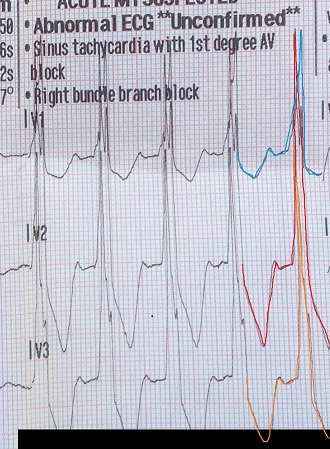I'm glad you guys thought of me, but I don't really feel like I have a really good answer for this.
I estimated the rate to be around 115 because I counted about 13 mm between complex #1 to #2 and then #2 to #3. The computer estimated a rate of 108, which means it measured an R to R interval that is about 1 mm further . That's not that far off. Computer is probably correct with the rate.
It's a regularly regular rhythm in my eyes. I'm not using calibers though. I honestly don't see anything that strikes me as a "definite" P-wave. I see some inconsistency with things that do look like P-waves eg after the second complex in lead II and lead III, and then after the fourth complex in lead III. It's not consistent. Also, in my experience, the P-wave is usually not very visible or easy to see throughout the entire ECG even on a normal 12-lead. I see what would look like a P-wave merged with the T-wave, but it is very easy to see through the ECG. I would consider this abnormal for a P-wave personally. The complexes are wide. I didn't measure it, but the computer estimated 146 ms (although barely, >140 ms is less likely to be due to RBBB). It has a RBBB-like morphology because it is positive in lead V1. In my opinion, it doesn't have a typical RBBB morphology of rsR' or qR or some variation of that. To me, it looks like a tall R-wave with an increase intrinsicoid deflection that kind of looks like a delta wave to me. In hypertrophy, it is common to see an increase an intrinsicoid deflection.

My poor attempt of outlining what I see.
I see people mistaken call left ventricular hypertrophy as an accessory pathway because they see this pseudo delta waves in the lateral leads. I'm not calling this left ventricular hypertrophy or any hypertrophy. Honestly though, this kind of looks like an avrt/WPW with a left sided accessory pathway (left side would create a RBBB-like morphology). Seems weird that this person wouldn't have on record that they have an accessory pathway or wouldn't know about it since they are at a skilled nursing facility. I don't really see too many avrt/WPW, so I am not even confident in this answer. This is just what I first thought of when I saw it and just kind of have a "feeling" that this is what it is. Not sure how to explain the lack of P-wave or if maybe at the terminal end of the T-wave is really a P-wave, but it just doesn't look like one to me. *shrugs*
When there is RBBB-like morphology, it is very normal for there to be ST depression in lead V1-3. In a normal RBBB that is small, it is hardly noticeable to the naked eye. In something like a VT or anything else with RBBB-like morphology that has bigger complexes, I consider this normal and not due an MI. While it is true that technically some of the T-waves are concordant with the terminal wave of the QRS complex, I personally believe that the direction of the T-wave should be discordant to the mean direction of the QRS in an intraventricular conduction delay rather than to the terminal wave (a purist would say it has to be discordant to the terminal wave, but who cares about what they say?

). I usually see this in lead V5 and V6 in some LBBB that have a biphasic T-wave and a tiny terminal S-wave. Computer probably tripping about there being an MI due to the excessive ST changes. I don't feel like the computer usually takes into consideration the amplitude of the QRS complexes so it commonly screams MIs on things like LBBB and LVH.
This does not look like Wellen's pattern to me.

